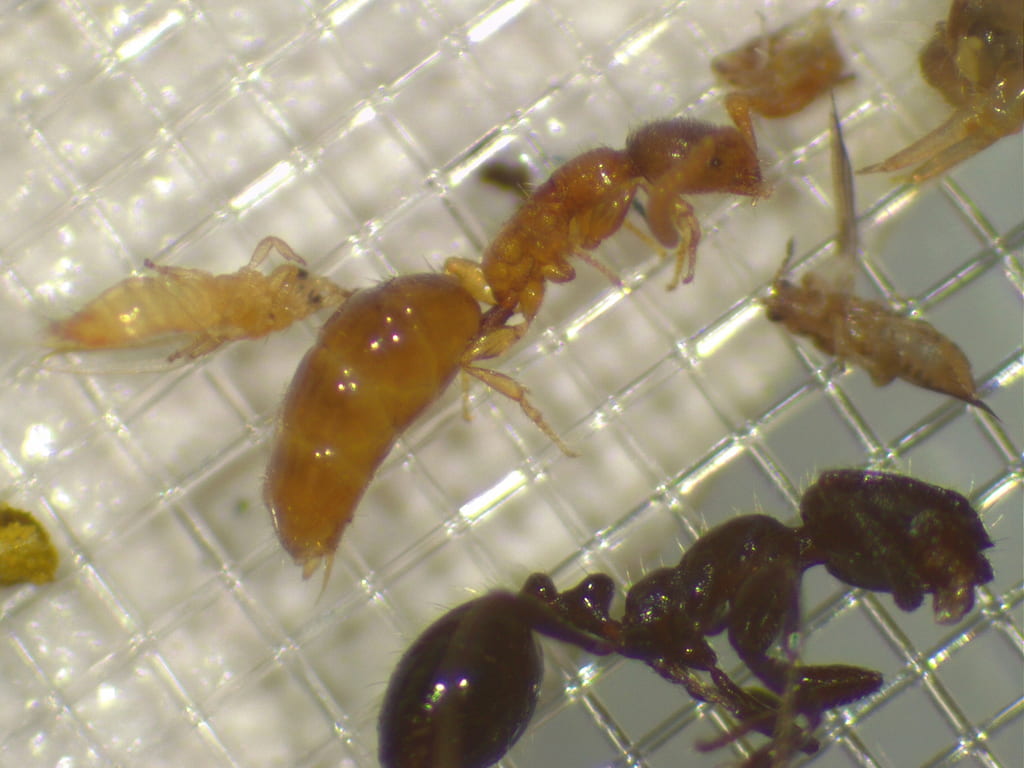Weekly progress:
Last week we sorted 3 kits: the kit by Y. Cecil (Jackson County), the kit by D. Thompson (Brown County), and the kit by L. Andrews (Athens Co) . We are over 12,200 bees pinned! We have also identified over 2,100 bees to at least genus.
Bycatch of the week:
Just in times for valentines day, we have ants in the genus Crematogaster.

This ant is known as a Cherry Ant, but the genus of ant is Crematogaster. Why is this relevant to Valentines day, you ask?

The genus Crematogaster has a distinctly shaped gaster (the butt). If you squint you can vaguely see the heart shape. So Happy Valentines day everyone!

Some say that mimicry is a form of flattery, so the ants should be properly flattered with this mimic. The top golden wasp is indeed a very good ant mimic. It took me a few minutes of getting excited about another weird ant and sending photos to the ant group for us to realize that it was in fact, not an ant.

The key character to determine if a wasp is an ant is the presence of a petiole/pedicel (marked with two black arrows on the black ant in the bottom of the image). Our mystery wasp had a thin and smooth waist between the thorax and gaster, and thus is not an ant.

This silken fungus beetle with golden hairs caught my eye last week. Not many beetles have dense hairs on their body.

The beetle seemed less than impressed to be here. However, it turns out this is actually a beetle associated with bumblebees! This is a species that lives in bumblebee nests and can sometimes be found hitching a ride on a bumblebee. That means sometimes you might find one of these beetles clinging to the face of an unfortunate bumblebee.

Andrews also had a lovely little fairy wasp, with long legs and feathery wings. I lost my grain of rice, but you could probably fit about 10-20 of these wasps on a single grain.

Have you ever thought of using a fly as both a bus and a food source? Well, these mites likely beat you to it. This unfortunate fly was host to over a dozen mites that were clinging to its abdomen!
Finally, let’s end our bycatch of the week with a rather weird fly.

Cecil’s kit had a single Stalk-eyed fly. There is only one other observation for stalk eyed flies in Ohio, so these are not common flies. They are thought to be associated with skunk cabbage, so I guess I need to look closer at some the next time I find a patch.
Although not from Ohio, this video highlights part of why stalk eyed flies are so cool. Check out how they pump up and expand their eyes!
Papers of the week:
Bees in the trees: Diverse spring fauna in temperate forest edge canopies by Urban-Mead et al.
They put traps in the canopy and found a lot of bees were still found foraging high up in the trees. This is even though most trees are considered “wind pollinated”.
“Wild bee abundance decreased by 48%, species richness by 20%, and strawberry fruit count by 18% across all farm with honey bee hives” Note that other studies in strawberry crops have found that honey bees were neutral or beneficial for crop yield of strawberries specifically. This study highlights that in some circumstances, honey bees can have a negative impact.
Helping in the lab in the age of Covid:
The lab is open to people interested in helping pin or sort specimens on a very limited basis. For now, the following caveats must be reached. 1) if you have managed to get both doses of a covid vaccine, or 2) you have already gotten covid, recovered, and can show both + then – covid tests. If you fit one of these exceptions and want to come to the lab to help out, please send an email to MaLisa at spring.99@osu.edu
Want to see how to get vaccinated against Covid-19 in Ohio or see if you qualify yet? See the vaccine distribution website here: https://vaccine.coronavirus.ohio.gov/
Events:
Saturday, February 27th, 9am – 3 pm: Ohio Natural History Conference (online and free!): Theme: Biodiversity & Technology: The Future of Natural History. Topics covered include telemetry, drones, and motion sensor cameras to document wildlife.
Register here: http://www.ohiobiologicalsurvey.org/
Friday, March 5th, 10 am – 12 pm: 2021 Ohio Wildlife Diversity Conference (online and free!):
Birds, millipedes, and snails! The talk lineup sounds like an eclectic mix of fun presentations and they are revealing two new ODNR booklets! Register here: https://ohiodnr.gov/wps/portal/gov/odnr/home/additional-resources/division-of-wildlife/2021-ohio-wildlife-diversity-conference-registration
All for now,
MaLisa
Happy Valentine’s Day MaLisa!
❤️🧡💛💚💙💜🌈
Interesting article:
https://www.nature.com/articles/s41598-021-81967-1